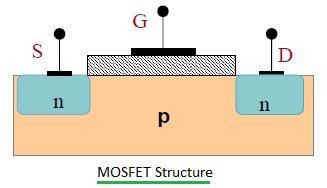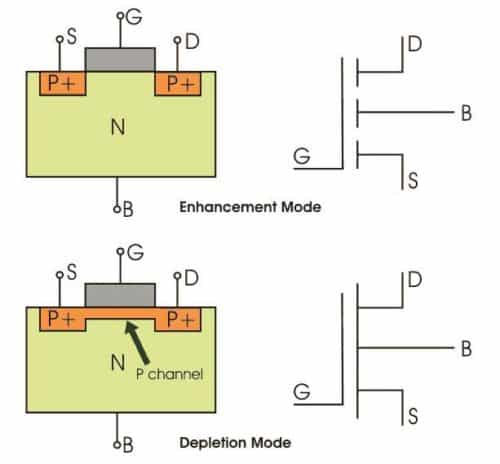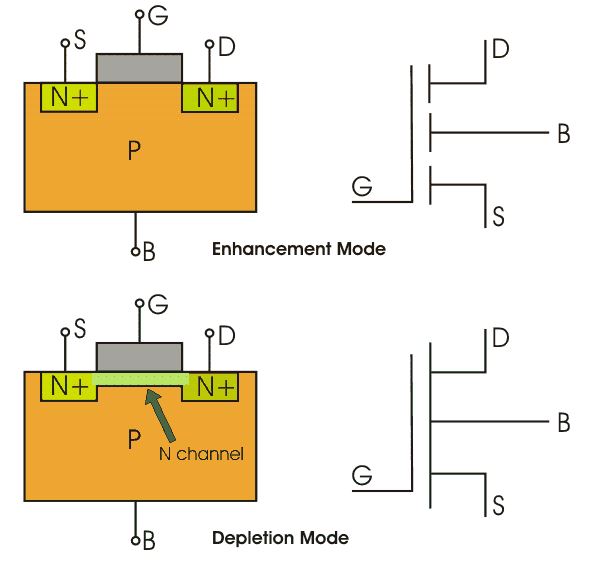A Metal Oxide Semiconductor Field-effect Transistor (MOSFET, MOS-FET, or MOS FET) is a field-effect transistor (FET with an insulated gate) where the voltage determines the conductivity of the device.
It is used for switching or amplifying signals. The ability to change conductivity with the amount of applied voltage can be used for amplifying or switching electronic signals.
MOSFETs are now even more common than BJTs (bipolar junction transistors) in digital and analog circuits.
The silicon dioxide forms the Gate of the MOSFET. It is used to provide isolation by preventing the direct flow of charges on the gate to the conducting channel.
A MOSFET is by far the most common transistor in digital circuits, as hundreds of thousands or millions of them may be included in a memory chip or microprocessor.
Since they can be made with either p-type or n-type semiconductors, complementary pairs of MOS transistors can be used to make switching circuits with very low power consumption, in the form of CMOS logic.
Why Choose MOSFET Over BJT?
MOSFETs are particularly useful in amplifiers due to their input impedance being nearly infinite which allows the amplifier to capture almost all the incoming signal. The main advantage is that it requires almost no input current to control the load current and that’s why we choose MOSFET over BJT.
Structure:

It is a four-terminal device with Source (S), Drain (D), Gate (G), and body (B) terminals. The body (B) is frequently connected to the source terminal, reducing the terminals to three. It works by varying the width of a channel along which charge carriers flow (electrons or holes).
The charge carriers enter the channel at the source and exit via the drain. The width of the channel is controlled by the voltage on an electrode called Gate which is located between the source and the drain. It is insulated from the channel near an extremely thin layer of metal oxide.
A metal-insulator-semiconductor field-effect transistor or MISFET is a term almost synonymous with MOSFET. Another synonym is IGFET for the insulated-gate field-effect transistor.
Different Types of MOSFET
MOSFET works in two modes-
1. Depletion Mode: The transistor requires the Gate-Source voltage (VGS) to switch the device “OFF”. The depletion-mode MOSFET is equivalent to a “Normally Closed” switch.
2. Enhancement Mode: The transistor requires a Gate-Source voltage (VGS) to switch the device “ON”. The enhancement mode MOSFET is equivalent to a “Normally Open” switch.
Now with respect to the working principle, MOSFET is classified as follows:
- P-Channel Depletion MOSFET
- P-Channel Enhancement MOSFET
- N-Channel Depletion MOSFET
- N-Channel Enhancement MOSFET
P-Channel MOSFET

The drain and source are heavily doped p+ region and the substrate is in n-type. The current flows due to the flow of positively charged holes, and that’s why known as p-channel MOSFET.
When we apply negative gate voltage, the electrons present beneath the oxide layer experience repulsive force and are pushed downward into the substrate, the depletion region is populated by the bound positive charges which are associated with the donor atoms.
The negative gate voltage also attracts holes from the P+ source and drain region into the channel region.
N-Channel MOSFET

The drain and source are heavily doped N+ region and the substrate is p-type. The current flows due to the flow of negatively charged electrons and that’s why known as n-channel MOSFET.
When we apply the positive gate voltage, the holes present beneath the oxide layer experience repulsive force, and the holes are pushed downwards into the bound negative charges which are associated with the acceptor atoms.
The positive gate voltage also attracts electrons from the N+ source and drain region into the channel thus an electron-rich channel is formed.
MOSFET Working Operation
The working principle of a MOSFET depends upon the MOS capacitor. The MOS capacitor is the main part of MOS-FET. The semiconductor surface at the below oxide layer is located between the source and drain terminals. It can be inverted from p-type to n-type by applying positive or negative gate voltages.
When we apply positive gate voltage, the holes present under the oxide layer experience a repulsive force, and holes are pushed downward with the substrate.
The depletion region is populated by the bound negative charges that are associated with the acceptor atoms. The electrons reach, and the channel is formed. The positive voltage also attracts electrons from the n+ source and drain regions into the channel.
Now, if a voltage is applied between the drain and source, the current flows freely between the source and drain and the gate voltage controls the electrons in the channel. If we apply negative voltage, a hole channel will be formed under the oxide layer.
Applications
- Amplifiers
- Regulation for DC Motors
- Constructions of Chopper Amplifiers
- Switching and Amplifying Signals
You can also check the slideshow Presentation given below:
The article was first published on 19 July 2017 and recently updated in June 2024.














Showing the ‘body’ terminal might confuse people already familiar with the schematic representation of the MOSFET as commonly seen in electronic schematics, which show the body tied to the source lead internally.
Usually the device is on in the depletion mode and off in the enhancement mode.
it is very easy and sensational notes for engineering
true
Thank You for your feedback.
Helpful explanation, thank you
very good explanation. excellent
Thank you for your feedback.
This is very useful basic but important information for learners. Some gif animations or java applets could have enhanced learning experience. For instance, showing characteristics with increasing voltage at pinch off position, recombinations of electron hole pairs, etc.
Good explanation.. thank you
You are most welcome.
Excellent ?
Thank you for your feedback.
i think in the p channel mosfet figure above , the G and D are wrongly marked..
Thank You for your comment. We have modified the figure.
The grammar is a little off
Hi Razavan, thank you for your feedback. Can you help modify and update this article?
“The electrons reach the channel is formed.” perhaps you could actually proof read before publishing such incredibly badly written work
Thank you for your feedback, we are modifying the article.